Physical Address
304 North Cardinal St.
Dorchester Center, MA 02124
For the experienced practitioner, the history and physical examination remains the most efficient, sensitive, specific, accurate, and cost-effective method of establishing a diagnosis in patients with knee-related complaints. Several investigators have demonstrated that the history and physical examination have equivalent sensitivity and specificity to magnetic resonance imaging (MRI) for a variety of intra-articular pathologies, with an overall accuracy of 93%. When taking a systematic approach to patients with knee-related concerns, assessing each structure in question sequentially for possible injury is critical.
Developing an intuitive and comprehensive approach to the physical examination requires a detailed understanding of knee anatomy, in particular the relation of the surface skin to the underlying structures, to be able to relate tenderness to pathology. In-depth knowledge of knee pathology can be helpful so that the history and examination can be dynamically tailored. From an organizational standpoint, it is helpful to stratify knee pathology based on onset (acute injury versus insidious onset) and population affected (adult versus pediatric; Table 90.1 ). Common acute knee injuries in adults include ligament injuries (including anterior cruciate ligament [ACL] tear, posterior cruciate ligament [PCL] tear, medial and lateral collateral ligament injury, and posterolateral corner [PLC] injury), meniscal tears, patellar dislocation/subluxation, patellar or quadriceps tendon ruptures, and fractures (most commonly patellar or tibial plateau). Additional acute injures that warrant consideration in the pediatric patient include physeal and apophyseal injuries (including tibial eminence avulsion fracture, tibial tuberosity avulsion fracture, or patellar sleeve avulsion fracture).
| Traumatic | Atraumatic | |
|---|---|---|
| Adult |
|
|
| Pediatric |
|
|
Common causes of insidious knee pain in the adult include patellofemoral pain (including patellofemoral syndrome, lateral patellar tilt, patellar and quadriceps tendinitis/tendinopathy), iliotibial band syndrome, degenerative meniscal tears, pes anserine bursitis, medial plica syndrome, patellofemoral and tibiofemoral chondral and osteochondral defects, and osteoarthritis, rheumatologic conditions, septic arthritis, and pigmented villinodular synovitis. Insidious knee pain in the child may also be secondary to osteochondritis dissecans (OCD), discoid meniscus, Osgood-Schlatter disease, Sinding-Larsen-Johansson syndrome, juvenile rheumatoid arthritis, lyme arthritis, and hip pathology such as Perthes disease or slipped capital femoral epiphysis (SCFE).
Eliciting the history starts with the chief or primary complaint that leads the patient to present for an evaluation. We endeavor to record this complaint in the patient's own words, because he or she provides the first clues regarding the patient's reason for the office visit. Asking an open-ended question such as “What brings you to the office today?” is very helpful. Giving patients the opportunity to “tell their story” also allows them to develop a more significant and meaningful relationship with their physician.
Once the patient has completed his or her initial response, the surgeon can return to the beginning of the story as necessary to fill in gaps and collect more details. In particular, the examiner must determine the duration of symptoms and, if possible, the date of onset. Important details often can be gathered from the patient's recollection of the inciting event or trauma, should one exist. If the injury occurred during an athletic endeavor, the examiner should obtain a full account of the event, including whether this incident was a contact or noncontact injury and if it occurred during practice or during a competition. These details may provide the first clues as to the underlying pathology. For instance, a valgus stress suggests an injury to the medial collateral ligament (MCL), whereas a high-energy trauma such as a motorcycle accident may suggest a knee dislocation or multiligamentous injury. In comparison, noncontact ACL injuries usually occur in the context of stopping quickly, cutting sharply, and landing and changing direction with the foot planted. The mechanism of ACL injury in skiers is different—when skiers injure the ACL, they are moving out of control with the knee bent or extended. The uphill arm is back, the body is off balance, the hips are lower than the knees, and the weight is placed on the inside edge of the downhill ski. This mechanism of injury has been referred to as the “phantom foot” mechanism. Recollection of an auditory pop or a tearing sensation may be present. Up to 66% of patients with an ACL injury describe such a sensation. Swelling immediately after the event may also occur. Indeed, a hemarthrosis develops in most persons with ACL injuries within 3 hours of the initial tear ( Table 90.2 ). It is often helpful to inquire about foot position during the injury. A fall onto a flexed knee may result in either a patellar fracture (if the ankle is dorsiflexed) or a PCL injury (if the foot is plantar flexed).
| Traumatic | Atraumatic |
|---|---|
|
|
If no specific event can be recalled, the patient should be asked if he or she has had a recent change in activity, which might suggest overuse. Commonly patients may have changed training techniques (e.g., increased frequency, increased distances, or a change in terrain or surfaces). A recent increase in running, particularly among marathon trainees or military recruits, may suggest a tibial stress fracture, patellofemoral syndrome, or iliotibial band syndrome. Acute changes from inactivity to activity may lead deconditioned patients to subject their knees to nonphysiologic kinetics as a result of loss of neuromuscular control.
The major symptoms on which to focus for a patient presenting with knee-related concerns include (1) pain, (2) instability, (3) mechanical symptoms, (4) swelling, and (5) stiffness. As with any patient encounter, the patient should be asked about the characteristics of pain, including onset (acute or insidious), location, duration, severity, quality, and radiation. The patient should be asked about the continued presence of pain and any change in character or severity of the pain. Use of visual analog scales can be helpful. Pain ratings based on a 0 to 10 scale can be used. It is helpful to hear whether the pain is constant, is only related to activities, or occurs after activity. Pain related to prolonged sitting or linear activities like stair climbing or running suggests a patellofemoral etiology, whereas pain with twisting or rotating activities (e.g., rolling over in bed or getting out of a car) is suggestive of meniscal pathology. Pain that arises at progressively earlier intervals into a run may be suggestive of iliotibial band syndrome.
Subjective instability should be explored, with attention paid to determining the frequency and inciting events or activities surrounding each instability event. For example, patients with an ACL tear often state that they experience instability with pivoting, twisting, or cutting activities. They may also describe a sensation of movement with their knees that they often explain by placing two fists together and moving one with respect to the other in what has been called the two-fist sign . In contrast, instability that is experienced linearly, as in walking on level ground or on stairs, is often associated with quadriceps weakness and deconditioning. Side-to-side instability on level ground may suggest valgus or varus laxity, whereas instability when descending a ramp may also be experienced by patients with damage to the PLC.
The presence of mechanical symptoms (catching and locking) is suggestive of a displaced intra-articular fragment, most commonly either a displaced meniscal tear or osteochondral loose body. A medial meniscal tear is more likely to promote mechanical symptoms while a lateral meniscal tear is more likely to present as pain in isolation. In addition, the presence of a bucket handle medial meniscal tear is suggestive of underlying ACL insufficiency until proven otherwise.
Although not universal, a knee effusion should heighten the examiners suspicion for a structural intra-articular abnormality. A knee effusion following an acute injury may be the result of a ligament injury, meniscal tear, chondral injury, or intra-articular fracture. The timing and size of the effusion are helpful clues to the diagnosis. Rapid onset (within 2 hours) of a large effusion is suggestive of an ACL tear injury or intra-articular fracture (e.g., tibial plateau) while a more gradual onset (24 to 36 hours) is more consistent with a meniscal tear. The presence of an effusion is also helpful in differentiating a patellofemoral chondral injury from patellofemoral syndrome.
The patient should be asked about any evaluation or treatment he or she received at the time of the injury or subsequent to the injury. It may also be helpful to know if weight-bearing restrictions were recommended. Knowledge of previous immobilization is also helpful, particularly if the patient has residual loss of range of motion (ROM). For any patient with a prior surgical intervention, the operative report and arthroscopy images can provide valuable information. Finally, the physician should ask which, if any, of these treatments have benefited the patient. These questions help guide the surgeon in creating a treatment plan that avoids the replication of prior failed treatments.
Once the history surrounding the present complaint is fully understood, the physician should collect general medical, surgical, and social histories. For athletes, a more complete understanding of their athletic history should be sought, including their current and past level of play; the number of hours per week that they play; and their skill level, potential, and athletic goals. These factors all play a role in surgical decision-making. In particular, in the patient with an ACL tear who plans to return to category I hard cutting or pivoting sports such as basketball, football, rugby, volleyball, or mogul/black diamond skiing, the risk for reinjury with nonoperative treatment of an ACL tear is high. The surgeon should also obtain an occupational history, because a patient who is reliant on the injured extremity for his or her livelihood likely requires a more aggressive treatment regimen.
A review of systems should always be collected as well. A particular focus should be placed on pain and swelling in other joints, eye disease, back pain, pain with urination, and skin disorders, all of which may hint at a diagnosis of an inflammatory arthropathy. Similarly, a history of fevers, night sweats, or drainage may lead the physician to suspect infection. A history of atraumatic knee pain with an associated mass with primarily nocturnal or constant pain may lead the physician to a neoplastic diagnosis. Pain out of proportion, hypersensitivity, and color and/or temperature changes to the knee should lead the physician to suspect a complex regional pain syndrome.
Finally, the physician must discuss goals and expectations with the patient. Expectations frequently need to be tempered. In athletes and former athletes presenting with a knee injury, it behooves the surgeon to come to a better understanding of whether the athlete would like to return to play (RTP) or simply desires a painless knee for activities of daily living. The patient is most likely to achieve a successful result if he or she understands the goals of the treatment program for the presumed diagnosis.
Physical examination of the knee requires an in-depth understanding of the anatomic structures and the function of these structures, because each provocative test seeks to isolate the function of each structure. We often view the examination as a multistep process: (1) inspection; (2) palpation; (3) ROM and strength testing; (4) patellar testing; (5) meniscal testing; (6) ligamentous stability testing; (7) gait assessment; (8) evaluation of muscle weakness and imbalance (e.g., hamstring tightness, quadriceps tightness, or core weakness); and (9) assessment of the back, hip, and feet. We start by examining the noninjured extremity, which may provide important information regarding baseline abnormalities and also helps to relax the patient.
A great deal of information can be gained from inspection of the patient before taking a history or performing a focused physical examination ( Box 90.1 ). If possible, patients should be observed as they enter the examination room or at some other time when they do not know they are being observed. Once the patient is in the examination room, the physician can gain insight into the patient's general mobility by observing his or her transfer from a chair to the examination table.
Atrophy
Effusion
Ecchymosis
Malalignment
Gait abnormalities
Extensor mechanism disruption
The periarticular skin should be carefully inspected for (1) any surgical scars, which may affect future surgical planning; (2) erythema, which should be demarcated with a skin-marking pen if it is believed to reflect an underlying cellulitis; (3) ecchymoses, which reflect subcutaneous hemorrhage that may signal a capsular injury ( Fig. 90.1 ); and (4) abrasions, which may provide a clue to the direction of the primary trauma. For example, with a dashboard mechanism, a patellar abrasion is concerning for patellar fracture, while an anterior tibial abrasion should raise concern for a PCL injury because of the posteriorly directed force on the anterior tibia at the time of injury ( Fig. 90.2 ). Attention should be directed to the presence or absence of effusion, any localized swelling, and muscle tone within the periarticular muscles—in particular the quadriceps and vastus medialis obliquus. The examiner should examine a patient with a suspected dislocation for the presence of any abnormal skin furrows or dimpling, which could signal buttonholing of the condyles through the capsule and the need for open reduction. Although general inspection may reveal atrophy, the most sensitive measurement of atrophy is a comparison of thigh circumference with the contralateral knee (typically performed 15 cm proximal to the superior pole of the patella; Fig. 90.3 ). This measurement can be used as a marker for the rehabilitation process after surgery. General inspection may reveal stigmata of other general medical conditions, such as signs of venous stasis, ulcerations, or prior amputations as a result of diabetic neuropathy or vascular insufficiency, as well as signs of chronic infections or abscesses. Predrawn knee schematics may be helpful for recording findings from visual inspection. Alternatively, obtaining a photograph at the time of presentation can be invaluable for comparison at a later date. Photographs can be entered into the electronic medical record. Serial examinations can be crucial for the determination of progression, especially in the acutely injured patient.
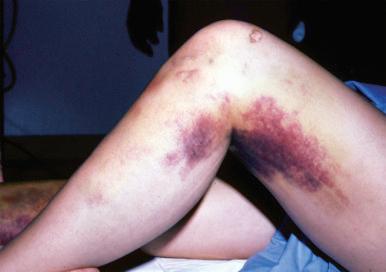
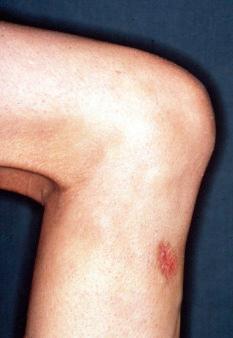
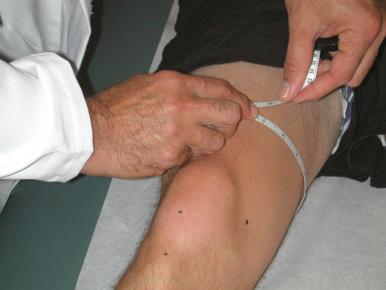
Patients should remove their shoes so that the entire limb can be inspected. Mechanical limb alignment should be visually estimated within the coronal, sagittal, and axial planes. The presence of genu varum, valgum, procurvatum, or recurvatum should be further evaluated radiographically. Specific attention should be directed to malrotation. With the patient supine, the examiner should also visually inspect the height level of the patella for alta or baja. The physician may also want to measure limb length. Although the most accurate method for limb length measurement is the placement of sized standing blocks under the short leg until the pelvis is level, a rapid, rough estimation can be gained with a glance at the relative heights of the medial malleoli in the supine patient. The physician can also estimate the Q angle visually and measure it with a goniometer, although this measurement can be affected by a variety of other deformities. Deformities within the foot should also be observed. For instance, pes planus may be a contributing factor to genu valgum or may be a sign of generalized ligamentous laxity. Gluteal strength can also be observed by asking patients to stand on one leg, perform a single-leg squat, or do repetitive single leg jumps. Inability to maintain a level pelvis, increased trunk lean, increased hip adduction, and excessive knee valgus during these activities is indicative of gluteal/core weakness that can indirectly contribute to patellofemoral symptoms.
The patient's gait should be observed. Although gait is a complex process requiring normal function of the foot, ankle, knee, hip, and lumbosacral spine, some gait abnormalities can also be referred to the knee. One should observe for varus and valgus thrusts, an antalgic gait with shortening of the stance phase for the affected limb, and the foot progression angle. Patients with ACL deficiency may exhibit a quadriceps avoidance gait, possibly to prevent excess anterior tibial translation.
It should be noted that many patients in the acute postinjury phase have generalized inflammation with diffuse tenderness that tends to be nondiagnostic; as a result, the patient may need to return at a later date for a repeat examination.
The knee should be palpated for the presence or absence of an effusion. The examiner can milk fluid down from the suprapatellar bursa while holding the patella between the thumb and forefinger of the contralateral hand to assess for the ability to ballot the patella. Alternatively, the examiner can feel for swelling at the soft spots medial and lateral to the patellar tendon, where the capsule is fairly subcutaneous. The other area where the surgeon may be able to palpate synovial fluid is in a Baker cyst, which is most commonly posteromedial between the semimembranosus and the medial head of the gastrocnemius.
The quadriceps tendon and its patellar insertion can be palpated both for tenderness associated with quadriceps tendonitis and a gap associated with a quadriceps tendon tear. The patella should be palpated for prepatellar tenderness or fullness that may be a sign of prepatellar bursitis. The distal pole of the patella and the patellar tendon origin should be palpated for tenderness associated with patellar tendonitis (or Sinding-Larsen-Johansson syndrome in adolescents; Fig. 90.4 ), as well as for a gap associated with a patellar tendon tear. The tibial tubercle should be palpated ( Fig. 90.5 ) for bony tenderness, which may be associated with Osgood-Schlatter syndrome.
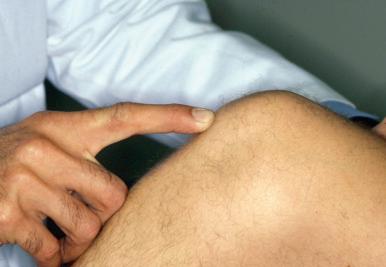
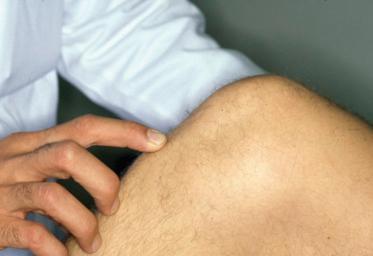
On the medial side of the knee, the entire course of the MCL should be palpated for tenderness. The femoral and patellar attachments of the medial patellofemoral ligament should be evaluated for a palpable gap or tenderness. The medial tibial plateau should be palpated for tenderness because it might be associated with an acute fracture or stress fracture. The region just anteromedial to the patella should be assessed for a palpable tender band from plica syndrome ( Fig. 90.6 ). The distal insertion of the sartorius, semitendinosus, and gracilis tendons should be palpated for pes anserine bursitis. The posteromedial joint line should also be palpated for a possible meniscal tear. Whereas anteromedial ( Fig. 90.7 ) and medial joint line tenderness is often associated with plica syndrome or hypertrophic fat pad syndrome, displaced bucket handle meniscal tears characteristically have more tenderness anterior than the classic posteromedial location associated with most meniscal tears.
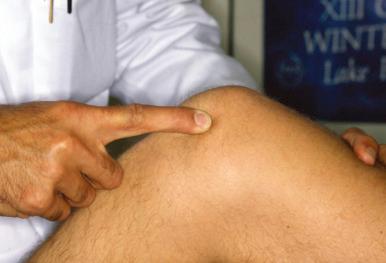
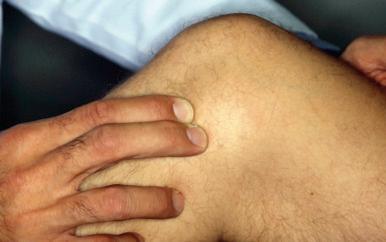
Similarly, the surgeon must also palpate the lateral structures. The lateral collateral ligament is best identified with the knee in the “figure-of-four” position, where varus stress makes the ligament taut and more easily palpable. The other structures of the PLC, such as the popliteus tendon and the popliteofibular ligament, can be more difficult to assess with palpation. The biceps tendon is most easily assessed as a cord at the posterolateral surface of the fibular head. Just anterior to the biceps tendon is the iliotibial band, which can be palpated as it passes over the lateral femoral condyle and at its tibial attachment at the Gerdy tubercle. The fibular head should also be assessed. The lateral tibial plateau should be palpated for tenderness, which might be associated with an acute fracture or stress fracture. The lateral joint line ( Fig. 90.8 ) is palpated for a possible meniscal tear. While medial meniscal tears are more likely to manifest with tenderness over the posteromedial joint line, lateral meniscal tears tend to be more tender over the midbody or anterior horn of the meniscus. Anterolateral joint line tenderness can be associated with hypertrophic fat pad syndrome. Just distal to the fibular head, the examiner can commonly palpate the common peroneal nerve. In patients with suspected pathology of the peroneal nerve, the examiner should attempt to elicit a Tinel sign. Pain associated with common peroneal neuritis may be referred to the anterolateral proximal tibial region.
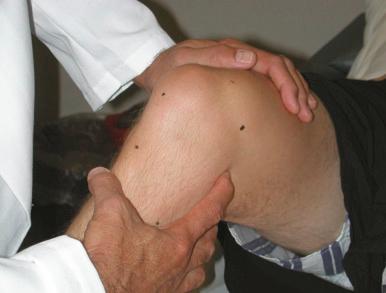
ROM is a fairly sensitive predictor of intra-articular pathology and is critical for knee function. Normal knee ROM has been described as 0 to 120 degrees, although the ROM actively used for gait is 10 to 120 degrees. However, considerable variation exists. At terminal extension, many persons have up to 5 degrees of hyperextension, which, in combination with range from 0 to 10 degrees of flexion, may be useful for the “screw home” mechanism of internal rotation that tensions the cruciate ligaments and “locks” the knee at full extension. Many persons have additional passive flexion beyond their active range; in men this is commonly 140 degrees and in women it is 143 degrees, although in societies where kneeling is common, such as in Japan, India, and the Middle East, passive flexion to 165 degrees is common. One hundred and twenty-five degrees of flexion are necessary to squat, whereas 110 degrees of flexion is required to descend stairs in normal fashion. The loss of as little as 10 degrees of flexion will affect running speed. The loss of as little as 5 degrees of extension can cause a limp with increased quadriceps activation during gait and resultant quadriceps strain and fatigue, as well as patellofemoral pain. Differences between passive and active ROM should be noted. A loss of both is considered a “contracture” and implies a block to motion, whereas a loss of active ROM with preserved passive ROM is considered a “lag” and implies a muscle tightness or imbalance.
Several methods may be used to test ROM. A goniometer can be placed on the lateral side of the knee with the proximal end pointed toward the greater trochanter and the distal end pointed toward the lateral malleolus. This method has high inter- and intraobserver reliability. A more sensitive indicator of full extension and flexion is the measurement of the heel-height difference with the patient placed in the prone position ( Fig. 90.9 ). Similarly, the heel-buttock distance can be measured in full flexion in the supine position. One centimeter correlates with approximately 1 degree.
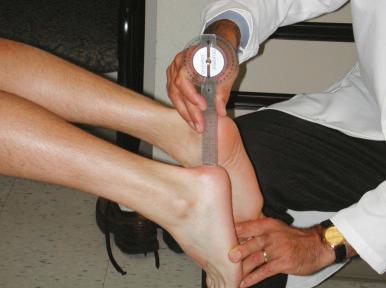
Restricted knee ROM must be understood in context. Postsurgical motion restriction is almost universally the result of either global or focal arthrofibrosis (e.g., cyclops lesion). Early studies suggested that up to 35% of patients undergoing ACL reconstruction experienced postoperative motion loss ; however, this has decreased to 0% to 4% with appropriate surgical timing, technique, and an accelerated rehabilitation program. Risk factors for postsurgical motion loss following ACL reconstruction include acute reconstruction (<1 week following injury), improper graft placement or tension during ACL reconstruction, concomitant extra-articular procedures (meniscal repair, collateral ligament reconstruction), prolonged immobilization, infection, and complex regional pain syndrome. Postinjury motion restriction in the acute phase may be the result of hemarthrosis or displaced intra-articular fragment (such as a displaced osteochondral fracture, ACL tissue flipped into the intercondylar notch, or displaced meniscal tear). In the acute phase, a displaced bucket handle meniscal tear is more likely to promote a more significant block to full extension (15 degrees or greater); however, after several weeks this may result in a subtle side-to-side difference (5 degrees or less).
ROM testing should also be performed on the ankle and hip joints and lumbar spine. We also commonly test for generalized ligamentous laxity, specifically by examining for elbow recurvatum, hyperextension at the metacarpophalangeal joint, the ability to abduct the thumb to meet the forearm, and excess external rotation of the humerus in adduction, all of which may signal a connective tissue abnormality. It should be noted that some confusion exists in the literature regarding the terms laxity and instability . Laxity is a term used to describe a finding on physical examination, whereas instability is a term used to describe a patient's subjective experience of this same entity. It is possible for a person to have generalized ligamentous laxity with no instability, and vice versa.
Several other structures can be assessed during ROM testing. For instance, if the patient reports lateral knee pain with a palpable snap, the examiner can flex the knee, internally rotate, and then extend the knee to elicit snapping of the biceps tendon over a prominent fibula head ( Fig. 90.10 ). This observation may not be detected with external or neutral tibial rotation. It is important to consider this entity because it can mimic an unstable lateral meniscal tear. More commonly, the patient should be assessed for hamstring tightness in the supine position with the examiner attempting to flex the hip with the knee extended. We grade hamstring flexibility in degrees from the examination table. In this same position, the patient should be assessed for the ability to perform a straight leg raise. The examiner may also wish to assess for iliotibial band tightness using the Ober test. In this test, the patient is placed in the lateral decubitus position with both hips and knees flexed to 90 degrees, so as not to flatten the lumbar spine. Concomitantly, the affected leg is abducted to 40 degrees and fully extended, and an attempt is then made to adduct the hip. An inability to adduct past midline signifies an iliotibial band contracture ( Fig. 90.11 ).
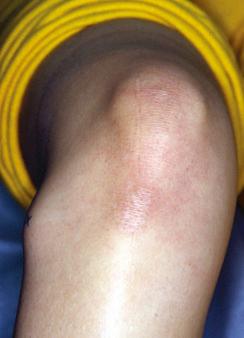
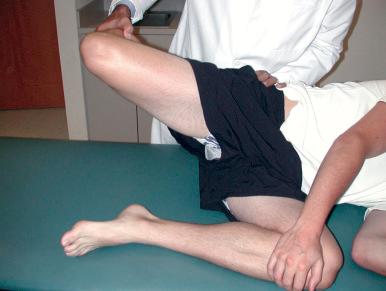
ROM testing is also an excellent time to assess muscular strength, including hip abduction, knee flexion and extension, ankle flexion and extension, foot eversion and inversion, and extension of the hallux. In a patient with demonstrable weakness, one must determine whether neuromuscular inhibition due to pain may be contributory. While testing distal strength, one should assess distal sensory function in the sural nerve at the lateral border of the foot, the saphenous nerve at the medial ankle, the superficial peroneal nerve over the dorsum of the foot, the deep peroneal nerve at the dorsal first web space, and the tibial nerve over the plantar surface of the foot. Patients with previous longitudinal anterior knee incisions should be assessed for residual numbness in the distribution of the infrapatellar branch of the saphenous nerve; any numbness would be lateral to any incision, because the nerve runs from medial to lateral. Whereas testing sensation to light touch is commonly sufficient for examination of the knee in the setting of a sports physician's office, testing with a 5.08 Semmes-Weinstein monofilament is the most sensitive method of testing for a sensory deficit in this region of the body and the preferred method in patients with suspected diabetic neuropathy.
The vascular status of the limb can be assessed with palpation of pulses at the posterior tibial artery at the posteromedial ankle, the dorsalis pedis artery over the proximal dorsal foot, and the popliteal artery at the posterior knee. Patients without palpable pulses require assessment with a Doppler device. This portion of the examination is crucial in the acute assessment of any patient with trauma to the knee, particularly patients with suspected or confirmed knee dislocations. These patients may require additional assessment with an ankle-brachial index, and any patient with an ankle-brachial index score of less than 0.8 requires further investigation with an angiogram or magnetic resonance angiogram.
While many clinicians lump all anterior knee complaints as patellofemoral syndrome/chondromalacia, a targeted physical exam can help discern between patellofemoral syndrome, patellar tendinitis, lateral patellar tilt, medial plica syndrome, and hypertrophic fat pad syndrome. To assess the retinaculum and peripatellar capsular structures, the examiner can assess patella mobility with the knee in extension before it engages with the trochlea ( Fig. 90.12 ). In anxious patients, the examiner may wish to repeat this portion of the examination with the patient in the prone position, which relaxes the quadriceps. The knee can then be flexed to 30 degrees when the patella has fully engaged into the trochlea where the retinaculum is tightened. At this position, patellar tilt can be assessed and palpated by attempting to lift the lateral patella from the lateral trochlea. Furthermore, the examiner should palpate the lateral edge of the patella and determine if static lateral translation of the patella is present in relation to the lateral femoral condyle and whether this translation is correctable. The lateral edge of the patella can be palpated to determine if it overhangs the lateral femoral sulcus; if anatomically positioned, both structures are palpable. The apprehension sign can be elicited by pressing laterally on the medial border of the patella ( Fig. 90.13 ). In a patient who has undergone a previous lateral release, a medially directed positive apprehension sign indicates an overzealous lateral retinacular release with subsequent medial instability. The examiner should also assess how far the patella can be translated laterally, which is then graded into quadrants. As a rule of thumb, the examiner should not be able to displace the patella more than half of its width laterally. The knee can then be taken through a flexion/extension cycle with the examiner's hand on the patella to feel for crepitus ( Fig. 90.14 ), as well as any dynamic maltracking ( Fig. 90.15 ). While observing patellar movement during ROM, one should determine whether the patella subluxes in extension or in flexion. Specifically the examiner should note the presence or absence of a “J sign” as the patella translates laterally out of the trochlea in terminal extension. Finally, with the knee in 60 to 90 degrees of flexion, the examiner can press with one hand on the patella and stabilize the ankle with the other hand while asking the patient to attempt to actively straighten his or her knee. If this maneuver elicits pain, the examiner should suspect patellofemoral pathology. The degree of flexion of the knee at the time of the pain may signal chondral injury more proximally versus distally within the groove. However, even in healthy patients, synovium can become entrapped between the patella and the trochlea and cause pain with compression against the patella.
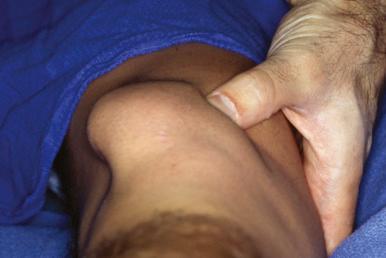
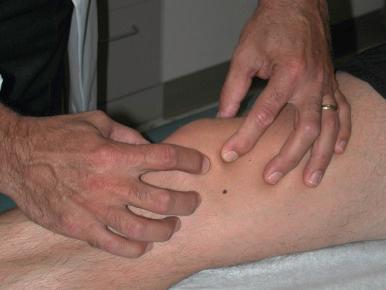
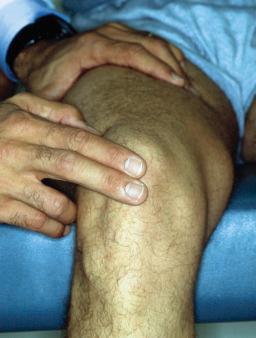
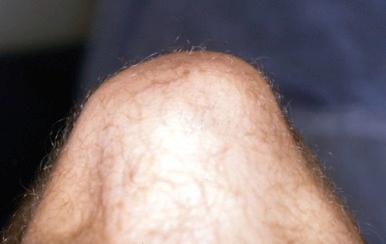
The Q angle should be observed with the knee between 70 and 90 degrees of flexion. It is also useful to assess the dynamic Q angle—the extent to which the Q angle increases with external rotation of the foot—as patients with patellar instability and an elevated dynamic Q angle may warrant consideration of tibial tubercle osteotomy. In a patient with a long-standing distal extensor mechanism reconstruction (e.g., Hauser procedure), the Q angle may be negative, with resultant posteriorization of the patellar force vectors. Arthroscopic assessment consequently will demonstrate severe medial patellofemoral arthritis as a result of this slingshot effect.
A variety of meniscal examination maneuvers have been described. In a recent meta-analysis of numerous previously published studies examining the sensitivity, specificity, and accuracy of the various physical examination tests for meniscal pathology, joint line tenderness was found to be the most sensitive test overall, whereas the McMurray test is the most specific. Joint line tenderness can be elicited with palpation as a sign of a meniscal tear, commonly posterior to the midaxial line in the sagittal plane, although a displaced bucket handle tear is more tender anteromedially or anterolaterally at the anterior apex of the “bucket.”
The most commonly used provocative meniscal test is the McMurray test, which is performed with the patient supine. To test the medial meniscus, the knee is flexed and brought into a varus stress and externally rotated and then slowly extended while palpating the medial joint for a mechanical click and asking the patient for any sensation of pain ( Fig. 90.16 ). To test the lateral side, the aforementioned maneuver is performed with a valgus stress. The senior author has not found the position of tibial rotation to be particularly sensitive; instead, we assess for pain referred to the affected compartment with hyperflexing, rotating, and extension maneuvers. The Apley test is performed with the patient in the prone position. The knee is brought into 90 degrees of flexion and then internally and externally rotated while applying an axial load ( Fig. 90.17 ). A positive test occurs with the reproduction of pain or a catching or locking sensation. In addition, the test can be repeated in distraction across the joint, with continued pain and symptomatology signaling an articular cartilage lesion instead of a meniscal tear. The bounce home test is performed with the patient supine with a flexed knee and the foot cupped in the examiner's hand. The knee is passively extended and allowed to bounce home into extension with a sharp endpoint. Inability to achieve full extension or the presence of a rubbery end-point is suggestive of an interposed meniscus or alternate loose fragment. The Thessaly test is performed with the patient's own weight causing the compression. In this test, the patient stands on the affected leg, supported with his or her outstretched hands by the examiner, and flexes the affected knee to 5 degrees while internally and externally rotating three times. The test is repeated in 20 degrees of flexion. In the original description of this test, the accuracy was 94% for medial meniscal tears and 96% for lateral meniscal tears, with all other tests having lesser accuracy—78% to 84% for the McMurray tests, 75% to 82% for the Apley test, and 81% to 89% for joint line tenderness.
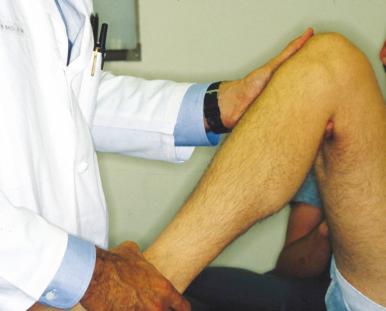
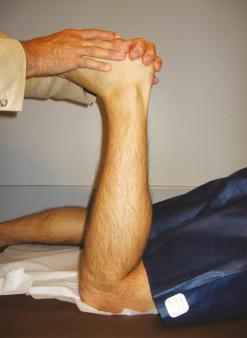
Ligamentous stability testing in the knee is among the most difficult to learn aspects of the physical examination and one of the most important portions of the examination. A variety of tests have been described for testing the ACL. The anterior drawer test is historically the oldest test but is the least sensitive. With this test, one attempts to anteriorly translate the tibia with the knee flexed to 90 degrees with the ankle stabilized. Generally this test is only positive with loss of not only the ACL but also the secondary restraints to anterior tibial translation such as the posterior horn of the medial meniscus (e.g., meniscal resection or an unstable peripheral meniscal tear). If the anterior drawer test is more positive than the Lachman test, one should suspect a PCL injury because the tibia is in a posterior resting position and is being translated to its neutral position. Increased anteromedial rotation of the tibia while flexed at 90 degrees is suggestive of a posteromedial corner injury.
The Lachman test is the most sensitive test for determining an ACL injury. The examiner attempts to anteriorly translate the tibia with the knee at 30 degrees of flexion ( Fig. 90.18 ). We perform this test with one hand stabilizing the distal femur and the other hand gripping the distal tibia such that a thumb is placed on the joint line and can palpate the translation of the tibia relative to the femur. This distance is then used to grade the test; grade 1 has 0 to 5 mm of translation, grade 2 has 5 to 10 mm of translation, and grade 3 has greater than 10 mm of translation ( Fig. 90.19 ). When compared with the opposite knee, the examiner should also assess for the true presence of a “soft” or “firm” end point. The sensitivity of the Lachman test is 94% to 98% in a patient who is awake.
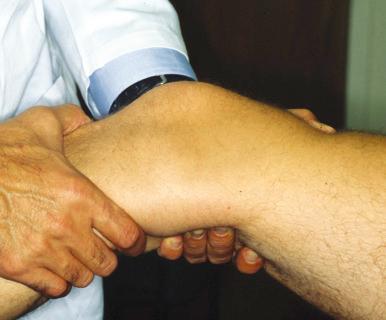
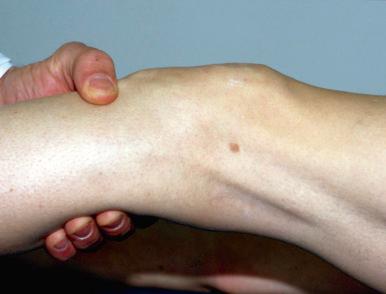
The most definitive test for assessing the functional integrity of the ACL is the pivot shift test, which characterizes the subluxation-reduction phenomenon of ACL deficiency. The goal of ACL reconstruction surgery is to eliminate the pivot shift regardless of the preoperative grade. Unfortunately, eliciting a positive pivot shift in the office can be difficult because patients are often apprehensive and guarding their knee. Furthermore, once a physician has elicited this sensation, subsequent efforts are usually met with patient guarding. In the office, we prefer to note that the patient is guarding on pivot shift maneuvers rather than stating that the test is negative. It is of interest that after reconstruction, if the ACL is functionally stable, the patient will allow the physician to perform multiple pivot shift attempts without apprehension. The pivot shift phenomenon is a complex combination of subluxation, rotation, and reduction motions. It is most easily conceptualized as a subluxation of the tibia in extension and a reduction with knee flexion. The pivot shift, as described by Galway (the Hughston “jerk test”) and Noyes (“flexion rotation drawer”), as well as the Losee test, the Slocum test, and the Bach-Warren test, are all subtle modifications of this phenomenon. An excellent overview of the various described maneuvers has been presented by Lane et al. It is critical to recognize that axial load and valgus force can have an impact on the grade of the pivot shift phenomenon. Incarcerated ACL stumps, displaced meniscal fragments, meniscal deficiency, associated ligamentous patholaxity (e.g., MCL), knee stiffness, arthritis, the position of the thigh when tested (abduction vs. adduction), and tibial rotation (external vs. internal rotation) can affect the pivot shift phenomenon. Perfecting this examination is an art form that takes years to master. It is easily inadequately performed, interpreted improperly, or sadly, not performed as part of an examination with the patient anesthetized prior to arthroscopic evaluation. We have encountered many patients who have been informed that they have a partial ACL tear (as determined by MRI, physical examination, and/or arthroscopy) but who are found to have an obvious pivot shift phenomenon upon careful examination.
To perform the pivot shift maneuver as initially described, the physician exerts a valgus and internal rotation moment on the tibia with the knee extended and then slowly flexes the knee ( Fig. 90.20 ). We also advocate abducting the hip (and externally rotating, not internally rotating, the tibia) to relax the IT band and eliminate its tenodesis effect. A positive result is a subluxing sensation at approximately 20 to 30 degrees of flexion. The biomechanical explanation for this maneuver is that in the ACL-deficient knee the tibia subluxes anteriorly at full extension. Valgus stress traps the lateral condyle in this subluxed position. With increasing flexion, the periarticular soft tissues exert an increasing ligamentotaxis effect, pulling the tibia posteriorly. Eventually this force causes the posterior lip of the tibia to be pulled posteriorly over the convex femoral condyle, reducing the knee with a palpable clunk. One modification of this test is the “pivot jerk” maneuver in which the knee is brought from flexion to extension with a similar valgus and internal rotation force, with the clunk experienced as the reduced tibia subluxes anteriorly.
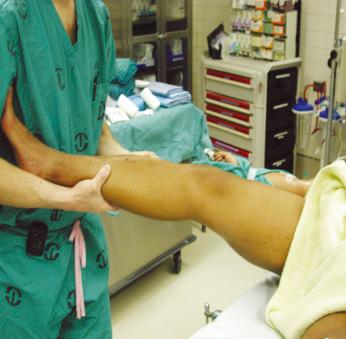
Several grading scales have been proposed for the pivot shift test. In the most commonly used scale, grade I is a gliding sensation without a palpable clunk, grade II is a palpable and sometimes audible clunk or jump, and grade III is a locked knee. Transient locking is usually observed with associated meniscal deficiency. In 1987, Jakob and colleagues proposed an alternate grading scale in which a grade I pivot is “trace”—that is, only elicited with the patient anesthetized; a grade II pivot is positive in internal rotation and neutral; and a grade III pivot is positive in external rotation and less obviously so in internal rotation. Conversely, Bach and colleagues noted improved sensitivity of the pivot shift test with hip abduction and tibial external rotation, an effect believed to be due to the tenodesis effect of the iliotibial band. The iliotibial band is one of several structures that can affect the ability of the ACL-deficient knee to pivot; with an MCL injury, valgus stress no longer causes a compressive force across the lateral compartment, and a flexion contracture of bucket handle meniscal tear prevents making full extension. Conversely, several injuries can accentuate the pivot further; injury to the PLC increases the examiner's ability to externally rotate the tibia and thus increase the pivot. A prior medial meniscectomy can also result in increased anterior tibial translation and an increased pivot shift.
Unfortunately, the pivot shift maneuver is subject to poor interobserver reliability because of the vast variation in force applied by the examiner during the maneuver. In addition, because of patient anxiety and guarding, these rotatory instability tests may be difficult to elicit. Any patient scheduled to have a surgical knee intervention should undergo repeat ligamentous testing once general anesthesia has been induced. Sensitivity of the pivot shift maneuver without use of an anesthetic has been described to be as low as 32% to 40%, rising to 97% to 100% with use of an anesthetic. The senior author can recall only a single patient in 30 years who, when examined after inducement of anesthesia, had a negative pivot shift despite complete ACL disruption. Authors of other studies have described sensitivities as high as 89% with the pivot shift maneuver. Almost all studies have described specificities for the anterior drawer, Lachman, and pivot shift tests in excess of 95%.
The most important examination for PCL diagnosis is the posterior drawer test. The knee is flexed to 90 degrees and a posteriorly directed force is placed on the tibia while the examiner feels and observes for posterior translation. Similar to the anterior drawer and Lachman tests, this test is commonly graded I for 0- to 5-mm translation, II for 5- to 10-mm translation, and III for 10- to 15-mm translation compared with the opposite knee ( Fig. 90.21 ). Differentiating between grades has important prognostic significance. A grade III injury may only be possible with concomitant injury to the PLC, capsule, and/or MCL and should cause the examiner to examine closely for such a combined injury. The posterior drawer test is the most sensitive and specific test for PCL injury, although in combination, these clinical examination tests have an accuracy of 96%, a sensitivity of 90%, and a specificity of 99%. In the quadriceps activation modification, the knee is brought to 70 degrees of knee flexion and the patient is asked to actively extend at the knee while the ankle is stabilized, while the examiner watches for anterior tibial translation (≥2 mm), which signifies an abnormally posterior resting tibial position. Normally the anterior medial tibial plateau extends 10 mm anterior to the medial femoral condyle. In a knee with a PCL injury, this step-off is reduced. In a grade I PCL injury, the tibial plateau sits ~5 mm anterior to the femoral condyles, in a grade II injury the tibia may be flush with the femoral condyle, and with a grade III injury the tibia sits posterior to the femoral condyles ( Fig. 90.22 ). The presence of a posterior sag sign is 100% specific for a PCL injury.
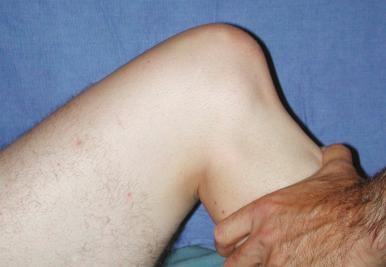
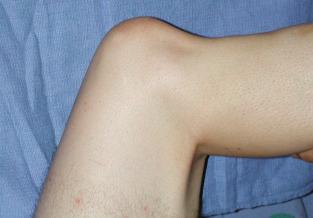
Testing of the MCL starts with palpation, as previously described, with which the examiner may be able to specify whether injury occurs at the proximal or distal end of the ligament. This differentiation may have prognostic clinical significance because proximal MCL injuries have been demonstrated to have a slower recovery of full ROM than distal MCL injuries. The integrity of the MCL can be tested clinically with the patient in the supine position and the ankle cradled between the torso and the elbow while the examiner's hand on the lateral side of the knee exerts a valgus stress and the hand on the medial side of the knee rests with fingers at the joint line to measure the tibiofemoral separation. Similar to tests for the ACL and PCL, this test is commonly graded I for 0- to 5-mm separation, II for 6- to 10-mm separation, and III for greater than 10-mm separation. This test should be performed at both full extension and 30 degrees of flexion ( Fig. 90.23 ). Although an isolated MCL injury will cause valgus laxity at 30 degrees, no laxity is observed at full extension without injury to the secondary restraints such as the cruciate ligaments, posterior capsule, or posterior oblique ligament. These tests must be interpreted in combination to determine the degree of injury (which, it should be noted, is separate from the grade of the valgus stress test), with first-degree injuries exhibiting tenderness without instability, second-degree injuries exhibiting laxity to valgus stress but with a firm end point, and third-degree injuries exhibiting laxity to valgus stress with no end point.
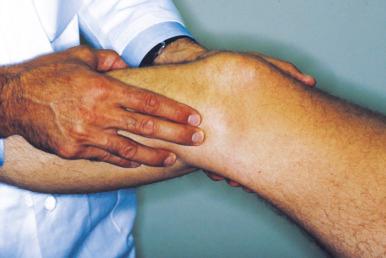
We commonly conclude with testing of the structures of the PLC. Similar to the medial side, the examiner can examine for tibiofemoral separation with varus stress at both full extension and 30 degrees of flexion ( Fig. 90.24 ), the latter of which tests the lateral collateral ligament. Also similarly, this test is commonly graded I for a 0- to 5-mm opening, II for a 5- to 10-mm opening, and III for a 10- to 15-mm opening. Similar to valgus stress testing, a positive result at 30 degrees suggests an injury to the lateral structures, whereas a positive result at 0 degrees suggests concomitant injury to the secondary stabilizers in addition to the lateral collateral ligament, cruciate ligaments, and posterior capsule. However, to fully test the remainder of the structures, the physician must also perform rotatory testing. The most commonly used rotatory test is the dial test, in which the physician attempts to maximally externally rotate both tibia at both 30 and 90 degrees of flexion ( Fig. 90.25 ). Side-to-side testing is crucial, and a side-to-side-difference of less than 10 degrees is considered a mild injury, whereas 10 to 20 degrees is considered moderate and greater than 20 degrees is considered severe. In general, an abnormality at 30 degrees of knee flexion is considered to be an isolated PLC injury, whereas abnormality noted at both 30 and 90 degrees requires injury to both the PLC and PCL. Of note, a complete MCL injury may also allow excess external rotation (because of anteromedial rotation of the tibia). The dial test can also be performed in the supine or seated position, again with the examiner assessing for asymmetric thigh-foot angles.
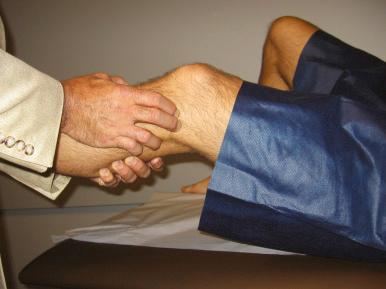
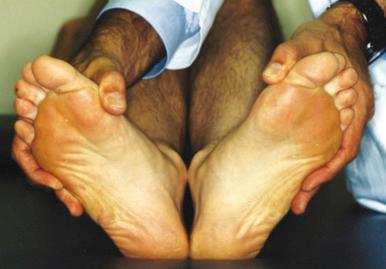
Several additional rotatory tests have been described, many of which describe overlapping functions of the PLC and PCL. For instance, in the recurvatum test, the examiner holds the knee extended by the hallux in the supine and relaxed patient, and observes for asymmetric and excess recurvatum and external rotation ( Fig. 90.26 ). Similarly, with the patient at 90 degrees of flexion and the ankle stabilized, the examiner can test the ability of the tibia to abnormally spin posterolaterally (also described as the external rotation drawer test), a finding most likely to be positive with both PCL and PLC injuries. In addition, a reverse pivot shift maneuver has been described in which the knee is held flexed and a valgus and external rotation stress is placed as the knee is extended, feeling for a reduction “clunk” at 30 to 40 degrees of flexion. In this maneuver, the tibia begins in a posteriorly subluxed position and is forced to reduce anteriorly with increasing extension. Although this test is most likely to be positive with both PLC and PCL injuries, it can also be positive with isolated injuries to either ligamentous structure. These tests have varying sensitivity; the posterolateral external rotation spin test has a sensitivity of 76%, and the external rotation recurvatum test has a sensitivity of 73%.
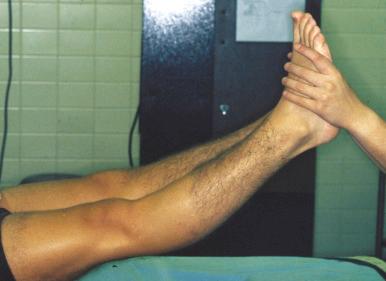
It should be noted that although these tests are not highly specific to any single structure within the PLC, the examiner may be able to gather some idea of which structures are injured based on the physical findings. Category A injuries have increased external rotation with injury to the popliteofibular ligament and popliteus tendon. Category B injuries have increased external rotation and opening to varus stress of 5 mm at 30 degrees of flexion with injury to the category A structures, as well as attenuation of the lateral collateral ligament. Category C injuries have increased external rotation and opening of 10 mm at varus stress at 30 degrees with injury to the category A structures, as well as tears of the lateral collateral ligament, lateral capsule, and possibly the cruciate ligaments. LaPrade and Terry found that a positive reverse pivot was associated with injuries to the lateral collateral ligament, popliteus, and mid third lateral capsular ligaments, whereas a positive spin test was associated with lateral collateral ligament and lateral gastrocnemius injuries, and a positive varus stress test was associated with injury to the posterior arcuate ligament. Patients with these injuries must be closely examined for injuries to the peroneal nerve as well.
Become a Clinical Tree membership for Full access and enjoy Unlimited articles
If you are a member. Log in here